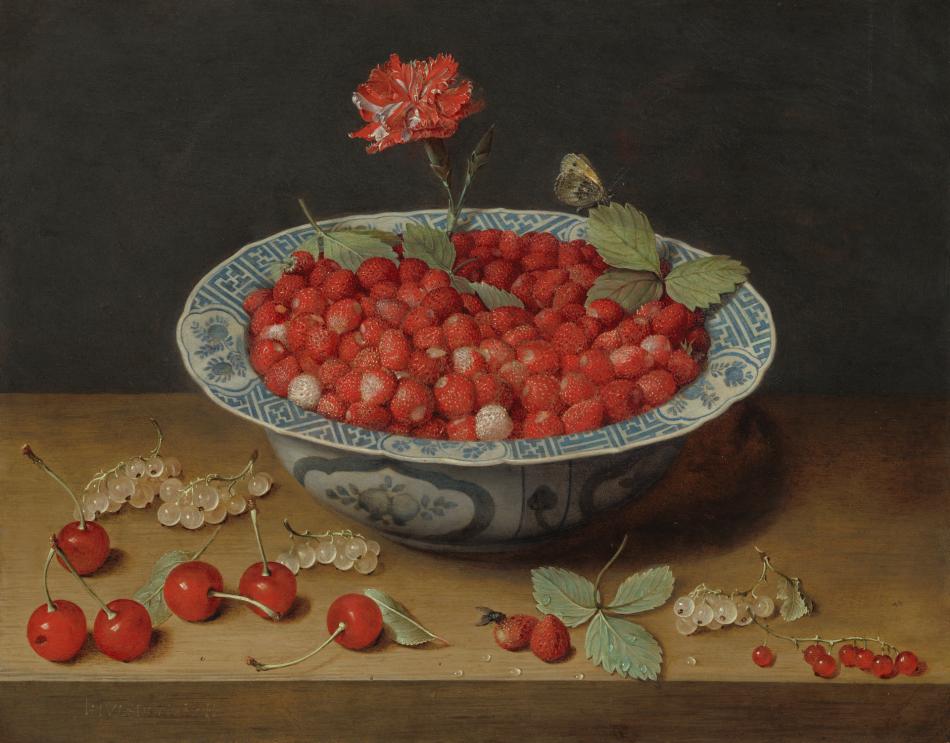Woman Weaving a Crown of Flowers
c. 1675/1680
Godefridus Schalcken
Painter, Dutch, 1643 - 1706
This charming portrayal of a woman who daydreams while weaving a crown of flowers is a fine example of Godefridus Schalcken's refined manner of painting. Its meticulous technique, particularly evident in the rendering of the costume, reflects Schalcken's connection to the Leiden fijnschilders (fine painters), who specialized in small genre scenes executed with extraordinary attention to detail. These gemlike pictures, filled with brilliant touches of color and light, found favor among collectors throughout Europe.
Woman Weaving a Crown of Flowers almost certainly alludes to the yearnings of a young woman for love and marriage. The crown of flowers refers to both of these themes, which are reinforced by the cupid atop the fountain and the young lovers in the distance. The crack in the stone base of the fountain nevertheless offers a warning that, over time, even the most solid foundation of love is fragile.
As a young man, Schalcken moved to Dordrecht, where he was apprenticed to Samuel van Hoogstraten (1627–1678). He then trained in Leiden under Gerrit Dou (1613–1675) and went on to establish himself as an independent master in Dordrecht by the mid-1660s. In 1692 Schalcken moved to the court of King William III and Queen Mary at Windsor, where for seven years he painted portraits of the Dutch-born king and the English aristocracy. In 1699 he settled in The Hague, where he worked for the rest of his life.

West Building Main Floor, Gallery 50-A
Artwork overview
-
Medium
oil on panel
-
Credit Line
-
Dimensions
overall: 26.7 x 20.3 cm (10 1/2 x 8 in.)
framed: 37.6 x 31.4 x 5.1 cm (14 13/16 x 12 3/8 x 2 in.) -
Accession Number
2005.26.1
More About this Artwork

Video: Two-Minute Tour: Clouds, Ice, and Bounty
Join exhibition curator Betsy Wieseman on a two-minute tour of the 2021-2022 exhibition Clouds, Ice, and Bounty.
Artwork history & notes
Provenance
Graf Lothar Franz von Schönborn [1655-1729], Schloss Weissenstein, Pommersfelden, from at least 1719;[1] by descent in the Schönborn family; (Schönborn sale, Hôtel Drouot, Paris, 17-18 and 22-23 May 1867, no. 111); purchased by De l'Espine. Comte de L*** [Lambertye or Lépine], Paris; (his sale, Hôtel Drouot, Paris, 15 April 1868, no. 57). Goldschmidt collection, Paris; (his sale, Galerie Georges Petit, Paris, 14 and 16-17 May 1898, no. 97); purchased by Fischer. Gabriel Cognacq [1880-1951], Paris; (his estate sale, Hôtel Drouot, Paris, 11-13 June 1952, no. 87); Princess Ermina Tonsson, Washington, D.C.; (sale, Christie's East, New York, 19 November 1980, no. 197); (P. de Boer, Amsterdam); purchased c. 1981 by private collection, New Rochelle, New York; (sale, Sotheby's, New York, 22 January 2004, no. 25); (Colnaghi, London); sold 16 March 2005 to NGA.
[1] The painting is listed in catalogues of the Schönborn collection published in 1719 (Fürtrefflicher Gemähld-und Bilder-Schatz / So in denen Gallerie und Zimmern / des Churfürstl. Pommersfeldischen..., Bamberg, 1719: no. 57); 1746 (Beschreibung des Fürtreflichen Gemähld- und Bilder-Schatzes..., Würzburg, 1746); and 1857 (Katalog der Gräflich von Schönborn'schen Bilder-Gallerie zu Pommersfelden, Würzburg, 1857: no. 96).
Associated Names
Exhibition History
1950
Chefs-d'oeuvres des collections parisiennes, Musée Carnavalet, Paris, 1950, no. 74, as La faiseuse de bouquets.
1981
Voorjaarstentoonstelling van nieuwe aan winsten, Galerie P. de Boer, Amsterdam, 1981.
1988
Dutch and Flemish Paintings from New York Collections, National Academy of Design, New York, 1988, no. 46, repro., as Young Woman Weaving a Garland.
2021
Clouds, Ice, and Bounty: The Lee and Juliet Folger Fund Collection of Seventeenth-Century Dutch and Flemish Paintings, National Gallery of Art, Washington, 2021, no. 4, repro.
Bibliography
1907
Hofstede de Groot, Cornelis. A Catalogue Raisonné of the Works of the Most Eminent Dutch Painters of the Seventeenth Century. 8 vols. Translated by Edward G. Hawke. London, 1907-1927: 5(1913): 348, no. 135, as A Young Girl tying up a Nosegay.
Hofstede de Groot, Cornelis. Beschreibendes und kritisches Verzeichnis der Werke der hervorragendsten holländischen Maler des XVII. Jahrhunderts. 10 vols. Esslingen and Paris, 1907-1928: 5(1912):362, no. 135.
1950
Musée Carnavalet. Chefs-d'oeuvre des collections Parisiennes. Exh. cat. Musée Carnavalet, Paris, 1950: 40-41, no. 74.
1986
Hecht, Peter, and Ger Luijten. "Nederland Verzamelt Oude Meesters Tien Jaar Aankopen en Achtergronden." Kunstschrift Openbaar Kunstbezit 30 (1986): 213-214, fig. 57.
1988
Beherman, Thierry. Godfried Schalcken. Paris, 1988: 244, no. 150.
Adams, Ann Jensen. Dutch and Flemish Paintings from New York Private Collections. Exh. cat. National Academy of Design, New York, 1988: 11, no. 46.
2007
Howard, Jeremy. "Two Years in Review at Colnaghi." In Colnaghi Old Master Paintings. London, 2007: introduction, fig. 7.
Inscriptions
lower left: G. Schalcken
Wikidata ID
Q20177665





